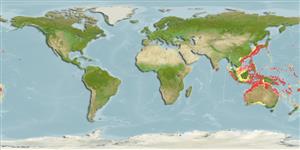Actinopterygii (ray-finned fishes) >
Scorpaeniformes (Scorpionfishes and flatheads) >
Triglidae (Searobins) > Pterygotriglinae
Etymology: Pterygotrigla: Greek, pterigion, diminutive of pteryx = wing, fin + Greek, trigla, es = red mullet (Ref. 45335).
Environment / Climate / Range
Ecology
Marine; demersal; depth range ? - 500 m (Ref. 9771). Deep-water, preferred ?
Indo-West Pacific: from Japan southward through the South China Sea, Indonesia, and northwestern Australia.
Size / Weight / Age
Maturity: Lm ? range ? - ? cm
Max length : 30.0 cm TL male/unsexed; (Ref. 559)
Dorsal
spines
(total): 7 - 9;
Dorsal
soft rays
(total): 11-12;
Anal
soft rays: 11 - 12. This species is distinguished by having the following characters: absence of scales on the nape, prepectoral area, breast, or interpelvic area; long and strong cleithral spine (16-29 % SL), P1 12+3; a slight indication of possible hyperostosis of the first infraorbital bone and cleithral spine (Ref. 91768).
A rare (Ref. 9771), benthic (Ref. 75154) species that inhabits continental shelves and insular areas.
Life cycle and mating behavior
Maturity | Reproduction | Spawning | Eggs | Fecundity | Larvae
Richards, W.J. and T. Yato, 2012. The tropical species of the subgenus Pterygotrigla (Pisces: Triglidae: Pterygotrigla) with description of a new species. Zootaxa 3484:53-64. (Ref. 91768)
IUCN Red List Status (Ref. 115185)
CITES (Ref. 94142)
Not Evaluated
Threat to humans
Harmless
Human uses
More information
Common namesSynonymsMetabolismPredatorsEcotoxicologyReproductionMaturitySpawningFecundityEggsEgg development
ReferencesAquacultureAquaculture profileStrainsGeneticsAllele frequenciesHeritabilityDiseasesProcessingMass conversion
Tools
Special reports
Download XML
Internet sources
Estimates of some properties based on models
Phylogenetic diversity index (Ref.
82805): PD
50 = 0.5000 [Uniqueness, from 0.5 = low to 2.0 = high].
Bayesian length-weight: a=0.01122 (0.00514 - 0.02450), b=3.04 (2.87 - 3.21), in cm Total Length, based on all LWR estimates for this body shape (Ref.
93245).
Trophic Level (Ref.
69278): 3.7 ±0.4 se; Based on size and trophs of closest relatives
Resilience (Ref.
69278): Medium, minimum population doubling time 1.4 - 4.4 years (Preliminary K or Fecundity.).
Vulnerability (Ref.
59153): Moderate vulnerability (36 of 100) .
